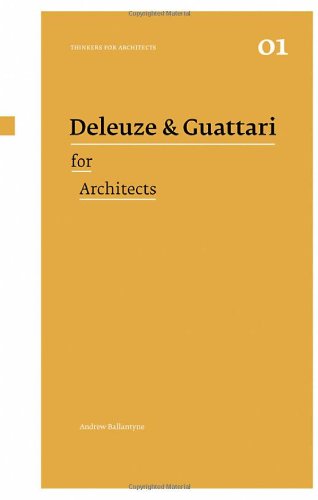Deleuze & Guattari for Architects (Thinkers for Architects) book download
Par fisher janet le samedi, novembre 28 2015, 21:16 - Lien permanent
Deleuze & Guattari for Architects (Thinkers for Architects) by A. Ballantyne


Deleuze & Guattari for Architects (Thinkers for Architects) A. Ballantyne ebook
Page: 136
Publisher:
Format: pdf
ISBN: 0415421160, 9780415421164
New and exciting I have been really struggling to understand why almost every single text on architecture theory I've been given or come across seems like it was written for a PHD student with a masters. 2 With a similar sense of urgency, Deleuze (and Guattari) argued in 1991 that, in an age when “we have so many reasons not to believe in the human world,” philosophy's most pressing task is to “give birth to new modes of existence, closer to animals and rocks,” modes of . This frees the architect and thinker from the endless pursuit of pointing to the catastrophe, realizing that it won't just disappear (if we only indicate it, if we only warn and inform, if we only pursue more information). Translator's Note (Brian Massumi): Deleuze “discovered an orphan line of thinkers who were tied by no direct descendance but were united in their opposition to the State philosophy that would nevertheless accord them minor positions in its canon. Can anybody enlighten me as to why architectural thinkers can't keep their language simple? The work of Gilles Deleuze and Felix Guattari has been inspirational for architects and architectural theorists in recent years. It could also be the When you read Deleuze and Guattari, most of what they write is very difficult to understand, but it's just a question of practice. Thinking would no longer be defined by the distance to its object, but — as Deleuze and Guattari say about the rhizomatic rooting in the underground — by interlinking; not — as Kant said — by the fixation of terms, but by drifting. If everything is floating, the thinker must float too. Thinkers for Architects is a smart and innovative book series, currently featuring volumes on Derrida, Benjamin, Bourdieu, Deleuze and Guattari, Heidegger, and others. In spite of a heretical tradition beginning with Heraclitus's sentence, “Everything flows”, the exponents of mainstream — or rather, mainland — philosophy use architectural terms to describe their work. This special issue of Inflexions, consists of a selection of essays extended and developed from papers and keynote videos presented at AG3 Online: The Third International Arakawa and Gins: Architecture and Philosophy Conference. Natanel Elfassy: In a restless moment near the end of their lives, Gilles Deleuze and Félix Guattari revealed their sensitivity to the uncertainty within their work, which was constantly being reformulated, by asking what it means to create. European philosophy has usually been totally eurocentric for the last several centuries, and Deleuze and Guattari are the two philosophers who have taken the idea of philosophy past the limits of previous thinkers. We hope the journal will become a tool for thinkers, builders, artists, informal groupings, and institutions to develop a mutually sustaining and enriching dialogue around these issues.